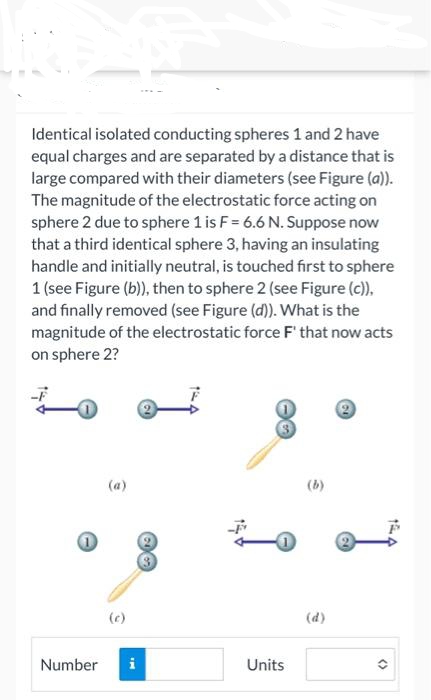Identical isolated conducting spheres 1 and 2 have equal charges and are separated by a distance that is large compared with their diameters (see Figure (a)). The magnitude of the electrostatic force acting on sphere 2 due to sphere 1 is F = 6.6 N. Suppose now that a third identical sphere 3, having an insulating handle and initially neutral, is touched first to sphere 1 (see Figure (b)), then to sphere 2 (see Figure (c)), and finally removed (see Figure (d)). What is the magnitude of the electrostatic force F' that now acts on sphere 2?
Identical isolated conducting spheres 1 and 2 have equal charges and are separated by a distance that is large compared with their diameters (see Figure (a)). The magnitude of the electrostatic force acting on sphere 2 due to sphere 1 is F = 6.6 N. Suppose now that a third identical sphere 3, having an insulating handle and initially neutral, is touched first to sphere 1 (see Figure (b)), then to sphere 2 (see Figure (c)), and finally removed (see Figure (d)). What is the magnitude of the electrostatic force F' that now acts on sphere 2?
Related questions
Question

Transcribed Image Text:Identical isolated conducting spheres 1 and 2 have
equal charges and are separated by a distance that is
large compared with their diameters (see Figure (a)).
The magnitude of the electrostatic force acting on
sphere 2 due to sphere 1 is F = 6.6 N. Suppose now
that a third identical sphere 3, having an insulating
handle and initially neutral, is touched first to sphere
1 (see Figure (b)), then to sphere 2 (see Figure (c)),
and finally removed (see Figure (d)). What is the
magnitude of the electrostatic force F' that now acts
on sphere 2?
(a)
Number i
Units
(b)
(d)
()
Expert Solution
This question has been solved!
Explore an expertly crafted, step-by-step solution for a thorough understanding of key concepts.
This is a popular solution!
Trending now
This is a popular solution!
Step by step
Solved in 2 steps with 2 images
